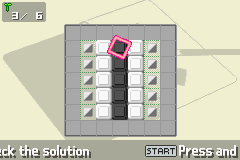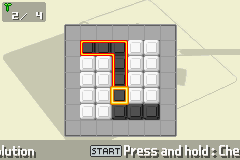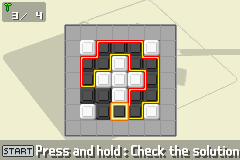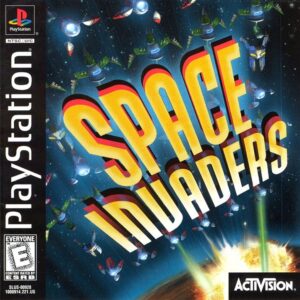Retro Replay Review
Gameplay
Polarium Advance retains the elegant, minimalist puzzle mechanics that made the original Nintendo DS title a cult favorite, tasking you with flipping rows of monochrome tiles to form solid lines of black or white. With the addition of Hurdle Tiles you cannot traverse, Multi-Tiles that count as either color, and Solid Tiles that remain fixed but disappear to let tiles above them drop, each stage demands fresh thinking and new tactics. The core loop of selecting and flipping lines remains intuitive, but these new block types add layers of strategy that reward experimentation.
The heart of the package is the Daily Polarium mode, offering 365 hand-crafted puzzles that range from simple warm-ups to brain-bending challenges. Each puzzle feels meticulously balanced—early levels ease you in with straightforward layouts, while later stages force you to juggle constraints, exploit border flips, and chain solutions to succeed. There’s a genuine “aha!” moment in every puzzle, and a satisfying rhythm develops as you progress through the calendar.
For players craving pressure, Time Attack mode delivers tense, stopwatch-driven runs. Decide whether to tackle ten easy puzzles for a quick confidence boost or five hard ones for a true test of speed and accuracy. Mistake a block and you incur a harsh 30-second penalty, turning what might be a casual session into a frantic scramble for the best time. It’s the perfect mode to hone your reflexes or settle head-to-head scores with friends.
Perhaps Polarium Advance’s greatest longevity comes from its custom puzzle editor. You can design your own grids, share them with friends who own the Game Boy Advance or the DS version, and tackle community creations in endless rotation. Cross-compatibility with DS puzzles means you have decades of user-generated content at your fingertips, ensuring weeks—or even months—of fresh challenges.
Graphics
Graphically, Polarium Advance embraces a stark, high-contrast aesthetic that suits the GBA’s limited palette. Tiles are rendered in crisp black and white pixels, making each flip instantly readable on even the dimmest screens. The stripped-back visuals strip away distractions, allowing you to focus purely on puzzle logic.
Despite the hardware constraints, the game’s presentation feels polished. Borders highlight the current selection line, and subtle shading on new block types (Hurdles, Multi-Tiles, Solids) ensures you never mistake one for another. Animations are brief but gratifying—tiles snap into place with a satisfying click, and when Solid Tiles vanish, a small cascade of dropped pieces completes the effect.
Sound effects are equally minimalist: a sharp “click” on each flip and a soft chime on puzzle completion. There’s no sweeping soundtrack, but the faint ambient hum in menus and the terse success cues reinforce the meditative atmosphere. Polarium Advance delivers clarity over flair, and it works exceptionally well on a handheld screen.
On a GBA SP’s front-lit display during a crowded commute, the game remains unambiguous and playable one-handed—just as the Japanese TV commercials intended. The visual design was optimized for on-the-go use, ensuring that each flip is registered correctly, even in bright sunlight or a rocking train carriage.
Story
Polarium Advance forgoes a traditional narrative in favor of pure puzzle immersion. There’s no character to save, no world to explore—just a blank slate of tiles and the mental challenge of aligning them. This absence of story might feel odd to players accustomed to plot-driven games, but it also means there’s zero filler. Every screen is focused entirely on gameplay.
Rather than weaving lore or dialogue, the game hints at its design philosophy through function: the new block types, the daily calendar, and the clean interface all convey a single message—solve puzzles. If you scroll through the Japanese TV ads, you’ll notice the emphasis on one-handed play and quick challenges, underscoring that Polarium Advance is about fit-and-finish, not fiction.
That said, a minimal sense of progression emerges organically as you conquer tougher grids and unlock custom creations. Each solved puzzle becomes a personal milestone, and a completed Daily Polarium set feels like a small triumph. The “story,” if it exists, is the narrative of your own improvement, puzzle by puzzle.
For those who crave character arcs or dramatic twists, Polarium Advance may feel bare. But for fans of pure puzzles, the lack of narrative clutter is a feature, not a bug—offering uninterrupted focus and endless replay without the need for cutscenes or exposition.
Overall Experience
Polarium Advance shines as a distilled puzzle experience on the Game Boy Advance. The core mechanic of flipping monochrome tiles remains as compelling as ever, and the three new block types introduce enough variety to keep veteran players on their toes. Daily Polarium delivers a year’s worth of levels, and the Time Attack and custom-puzzle modes add replay value that few GBA titles can match.
The minimalist graphics and sound design work in perfect harmony with the gameplay, ensuring clarity under any lighting condition and on any GBA model. Although the game lacks a traditional story or character progression, its steady stream of puzzles and the personal satisfaction of solving complex grids create a uniquely rewarding loop.
Polarium Advance is ideal for anyone looking for bite-sized mental challenges during commutes, coffee breaks, or long waits. It’s the kind of game you can dip into for a few minutes or binge through dozen-puzzle marathons without fatigue. Even without flashy visuals or a dramatic plot, it remains deeply engaging.
Whether you’re a seasoned puzzler seeking new mechanics, a casual player wanting quick bursts of mental stimulation, or someone interested in creating and sharing your own brainteasers, Polarium Advance has something to offer. Its simple premise, enhanced by smart additions and a robust editor, makes it a standout title in the handheld puzzle genre.
 Retro Replay Retro Replay gaming reviews, news, emulation, geek stuff and more!
Retro Replay Retro Replay gaming reviews, news, emulation, geek stuff and more!









Reviews
There are no reviews yet.